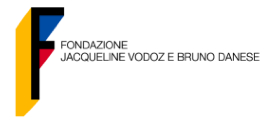Slide Slide Slide
Lary 7, Bradley Eros, Sandra Gibson & Luis Recoder, Barbara Hammer, Jeanne Liotta, Bruno Munari, Luther Price, Joel Schlemowitz, Michael Snow
September 5 – October 6, 2015
Opening Reception Friday September 5th, 6-9pm
Special events w/ works by Gill Arno, Ken Jacobs, George Maciunas, Raha Raissnia, and more
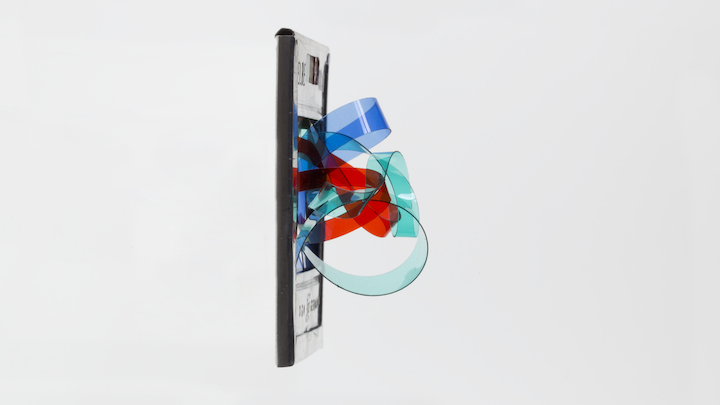
Bruno Munari, “Untitled”, 1952, slide for multi-focal projection, mixed media on slide, 2 x 2 x 1 inches – Courtesy Fondazione JVBD Milano
“Modern living has brought us music on records, and now projected painting.” – Bruno Munari, 1954
Microscope Gallery is very pleased to announce the opening of the doors at its new location with Slide Slide Slide, an exhibition dedicated to the art of the projection slide. The exhibit assumes as its inspirational starting point the works and words of Italian artist Bruno Munari who in the early 1950s was actively and extensively realizing the new possibilities of the slide as an art object and exhibiting his works including at the Museum of Modern Art in 1954.
Slide Slide Slide features slide installations by eight contemporary artists working with and expanding the notion of the art of the transparent slide including single and double projections, multi-projector/multi-slide, hand-painted and hand-drawn, gelled and mirrored, magic lantern, carousel and light box with subjects ranging from gender politics to abstraction to colored light: Lary 7, Bradley Eros, Sandra Gibson & Luis Recoder, Barbara Hammer, Jeanne Liotta, Luther Price, Joel Schlemowitz, and Michael Snow. While some of Munari’s forward thinking concepts are now realized in current digital mediums and technologies – such as the ability to “carry an entire exhibition in your pocket” – the works on exhibit result from and expand upon possibilities arising solely from the meeting of the transparent slide with projected light.
Each of the artists in Slide Slide Slide are recognized for their work with multiple mediums including celluloid film and digital video. But it is the specific nature of the slide itself the motivation behind all the works on view – one that is not photography, not film, not painting, not drawing, yet able to incorporate elements of each as well as those inherent to its own technology. Works include Michael Snow’s single carousel “Slidelength” (1969-1971); Luther Price’s “Light Fractures” (2013) consisting of 80 handmade slides; and premieres of: Barbara Hammer’s “Identity Redux” based on her 1995 film “Tender Fictions”; Bradley Eros’ “Silver <> Mirror {27 + 27 + 27 = 81}” with projection on silvered mirror; Joel Schlemowitz’s 4-projector installation “A Gallery of Ektagraphic Elegies”; Jeanne Liotta’s “Tempr II”, single slide with ink on exposed 120 film negative projection; Sandra Gibson & Luis Recoder’s composition of monochrome slides on light box “Color Transparency”; and Lary 7’s lantern double glass slide projection “Social Club”.
Microscope is also pleased to be able to include videos of several of Munari’s multi-focal single slide works projecting at various focus points, the sole manner in which this series by the artist who died in 1998, at the age of 91, can be seen in action today. Slide Slide Slide incorporates a series of live expanded slide show or other slide-related screenings that will take place over the course of the exhibition with works by many of the artists on view as well by Gill Arno, Kenneth Zoran Curwood, Ken Jacobs, George Maciunas (presented by Jonas Mekas), Raha Raissnia, Alexia Welch among others, the details of which will be announced separately.
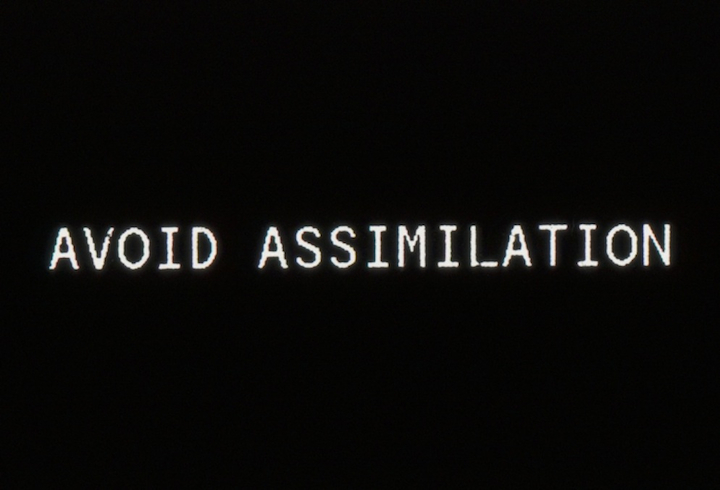
From Barbara Hammer’s single carousel projection “Identity Redux” (2014)
© 2014 – courtesy of the artist
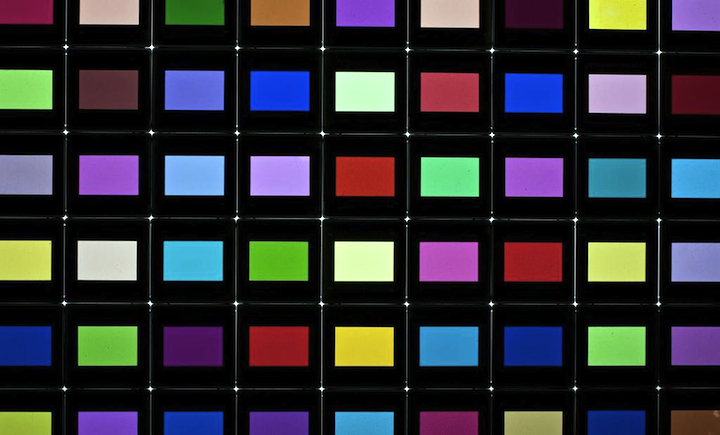
Sandra Gibson & Luis Recoder’s “Color Transparency” (2014) (detail)
© 2014 – courtesy of the artists
_
Lary 7 (born in Buffalo, New York) is a multimedia artist whose work mainly features analog, vintage and forgotten electronic instruments and technologies of the 20th century. Lary 7 is a co-founder of Plastickville Records and has been a major figure in the New York experimental underground music scene since 1970. Prior to living in New York City, 7 studied with Paul Sharits, Tony Conrad, and Hollis Frampton at SUNY Buffalo. In the course of the past decades he has worked on exceptional musical projects with diverse artists such as Jimi Tenor, Jarboe, Foetus, Tony Conrad, Alexander Hacke, Larry Mullins, Dorit Chrysler, Bernhard Gal, Jakob Kirkegard, Ken Montgomery, Michael Evans and Gordon Monahan among others. In 2013, Lary 7 was one of the last artists-in-residence at the Clocktower Gallery’s epic lower Manhattan location. Audio Visual Arts gallery in New York presented a solo exhibition of his work early this year.
Bradley Eros is a Brooklyn-based artist working in myriad mediums including film & video, collage, performance, contracted and expanded cinema & installation. Eros works have exhibited and screened extensively in the US and abroad including at Microscope Gallery, The Whitney Biennial, The Whitney Museum’s series The American Century, The Museum of Modern Art (MoMA), The Andy Warhol Museum, MoMA PS1, Camden Arts Center (London), Anthology Film Archives, Arsenal (Berlin), Participant Inc., The Kitchen, Performa09, Exit Art, White Box, and The New York, London and Rotterdam Film Festivals. Collaborations include the Alchemical Theater, the band Circle X, Voom HD Lab, and the expanded cinema groups kinoSonik, Arcane Project and currently Optipus.
Collaborators since 2000, Sandra Gibson and Luis Recoder unite the rich traditions of the experimental film, particularly its structuralist and materialist strands, and the multi-modal sensibility of expanded cinema that emerged in the 1960s, in which the moving image was woven into the labile space of performance, sound and audience interaction. Based in New York City, Gibson and Recoder have exhibited their work internationally in venues such as the Whitney Museum of American Art (NY, NY), Madison Square Park Conservancy (NY, NY), Performa (NY, NY), Redcat (Los Angeles, CA), Ballroom Marfa (Marfa, TX), Robischon Gallery (Denver, CO), Sundance Film Festival (Park City, UT), Contemporary Art Museum St. Louis (St. Louis, MO), Toronto International Film Festival (Toronto, Canada), Tate Modern (London, UK), Institute of Contemporary Arts (London, UK), Viennale (Vienna, Austria), Kurzfilmtage Oberhausen (Oberhausen, Germany), HMKV (Dortmund, Germany), MuHKA (Antwerp, Belgium), International Film Festival Rotterdam (Rotterdam, The Netherlands), Atelier Impopulaire (Milan, Italy), Serralves Foundation (Porto, Portugal), and the 21st Century Museum of Contemporary Art (Kanazawa, Japan).
Barbara Hammer (born 1939 Hollywood, CA) is a visual artist working primarily in film and video, having made over 80 moving image works in a career that spans 40 years. She is considered a pioneer of queer cinema. Her practice also includes performance, installation, photography, collage and writing. In 2013 she received a Guggenheim Fellowship for the film Waking Up Together on the poet Elizabeth Bishop. Her works “Optic Nerve” (1985) and “Endangered” (1988) were selected for the Whitney Museum of American Art Biennials (’85,’89,’93). Hammer’s work has appeared in retrospectives at The Museum of Modern Art, The Tate Modern, London, Jeu de Paume, Paris, and the Kunsthall Oslo. Her most recent films, Generations, 2010 (made with Gina Carducci), and Maya Deren’s Sink (2011), won the Teddy Award for Best Short Films at the 2011 Berlinale. Barbara Hammer lives and works in New York City and Kerhonkson, New York
Jeanne Liotta was born and raised in NYC where she makes films and other ephemera – including photographs, works on paper and live projection performances. Her latest body of work takes place at a curious intersection of art, science, and natural philosophy. Her 16mm film “Observando El Cielo” was voted one of the top films of the decade by The Film Society of Lincoln Center, was awarded the Tiger Award for Short Film at Rotterdam International Film Festival, and was selected as one of Artforum’s Top Ten Films of 2007. Her work has been presented in the 2006 Whitney Biennial, The New York Film Festival ; KunstFilm Biennale, Cologne; The Wexner Center for the Arts, The Museum of Modern Art; and The Sundance Channel among others. She has received awards from The Jerome Foundation, New York State Council on the Arts, The Museum of Contemporary Cinema, among others. She is currently on the Faculty of the Film Studies Department at the University of Colorado Bolder and at the Milton Avery Graduate School for the Arts at Bard College. Liotta lives between New York and Denver, Colorado.
Bruno Munari was born in Milan in 1907. Munari worked in a great variety of mediums including painting, sculpture, light installation, film, performance, and design. In 1927 he took part with Marinetti and Prampolini in the so-called “Second Futurism” exhibition at the Galleria Pesaro in Milan, and continued to exhibit with them through the 1930s. In 1948 he founded the MAC (Concrete Art Movement) along with Monnet, Dorfles and Soldati, and exhibited the first “Illegible Books”. From 1950 Munari started working on what he called “projected painting”, using various transparent materials inserted between the two glasses of a slide and projected on large walls or surfaces. He would later expand on this first example of “direct projection” by creating less static and more performative works in which the image is altered through the use of a polarizer filter (polarized projection) or by adjusting the projector’s focus (multi-focal projection). In 1964 he made a series of images obtained with the use of a Xerox machine, and began to install xerox machines at exhibition sites, including the Central Pavilion of the 35th Venice Biennale in 1970. Munari’s work was most recently featured in the Guggenheim Museum’s “Italian Futurism 1909-1944: Reconstructing the Universe” exhibition. He died in Milan on September 30th 1998.
Luther Price lives and works in Revere, Massachusetts. His work in film, performance, and installation has been shown extensively, nationally and internationally. Recent exhibitions and film screenings include Luther Price Lost and Found, transmediale, Berlin, 2014; Now and Forever, CIRCUS Gallery, Berlin, 2013; How Deep is Your Love? Dirty Looks at MoMA/PS1, 2013; E’wao Kagoshima and Luther Price, Vilma Gold, London, 2013; James and Audrey Foster Prize, ICA, Boston, 2013; Luther Price Retrospective, International Short Film Festival Oberhausen, curated by Ed Halter, 2013; Xavier Hufkens, Belgium, curated by Clarissa Dalrymple, 2013; Tom Rhoads (Luther Price), Dirty Looks at The Kitchen, New York, 2013; 7 Films by Luther Price, ICA, London, 2012; Second Nature: Abstract Photography Then and Now, DeCordova Sculpture Park and Museum, Lincoln, MA, 2012; #9, Callicoon Fine Arts, New York, 2012; Whitney Biennial, 2012; A Luther Price Bestiary, Views from the Avant-Garde, New York Film Festival, Curated by Mark McElhatten and Gavin Smith, 2012; Alone in the Dark: Projected Phobias, San Francisco Cinematheque, 2010. Price studied Sculpture and Media/Performing Arts at the Massachusetts College of Art and Design (BFA 1987) where he currently teaches. Price is represented by Callicoon Fine Arts, New York.
Joel Schlemowitz is Brooklyn artist working with multiple mediums including celluloid film, installation and collage. In addition to his two solo shows at Microscope Gallery, Schlemowitz has previously exhibited at Courthouse Gallery at Anthology Film Archives, NY; KUMUKUMU Gallery, NY; Bound & Unbound Gallery, NY; Museum of Contemporary Cinema, Madrid; Ukrainian Institute of America, NY; and The Images Festival, Toronto, Canada). His films are widely screened at cinemas, festivals, and institutions including at The Museum of Modern Art, The Whitney Museum, Harvard Film Archives, Brooklyn Academy of Music (BAM), the New York Film Festival, Tribecca Film Festival, New York Underground Film Festival, The London Film Festival among many others. He has received grants from the Jerome Foundation and New York State Council on the Arts.
Michael Snow was born in Toronto in 1929. He studied at Ontario College of Art and soon established himself as a successful painter and musician. In 1962, he moved to New York City and became acquainted with the avant-garde film scene centered around Jonas Mekas’ Filmmakers’ Cinematheque. It is in NYC, that his groundbreaking 1967 film Wavelength, which includes a 45-minute camera zoom within a fixed frame and is now considered as a landmark work of structuralist filmmaking – screened for the first time. Today, Snow continues to work with the moving image and is recognized as one of Canada’s most important living artists. Michael Snow has had solo exhibitions among others at the Art Gallery of Ontario, Toronto; XXV Venice Biennale; The Museum of Modern Art, New York; Centre George Pompidou, Paris; Kunstmuseum, Luzern, Switzerland; List Gallery, MIT, Cambridge, Massachusetts. Large retrospectives of his films were presented at Pacific Film Archive, San Francisco; Walker Art Center, Minneapolis; Osterreichisches Film Museum, Vienna; Image Forum, Tokyo; Cinémathèque Française, Paris; and Cinémathèque Royale de Belgique, Brussels, and many others. Among his many awards are a Guggenheim Fellowship, the Order of Canada, and two Los Angeles Film Critics Awards. Michael Snow exhibited is represented by Jack Shainman Gallery, New York. He currently lives and works in Toronto, Canada.
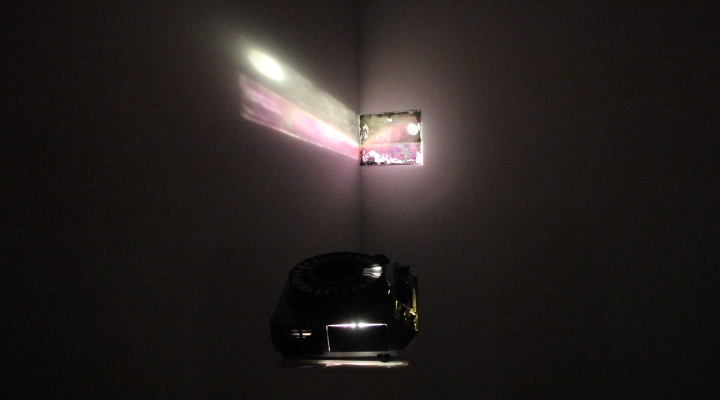
Bradley Eros’ “Silver <> Mirror {27 + 27 + 27 = 81}” (2014) (installation view)
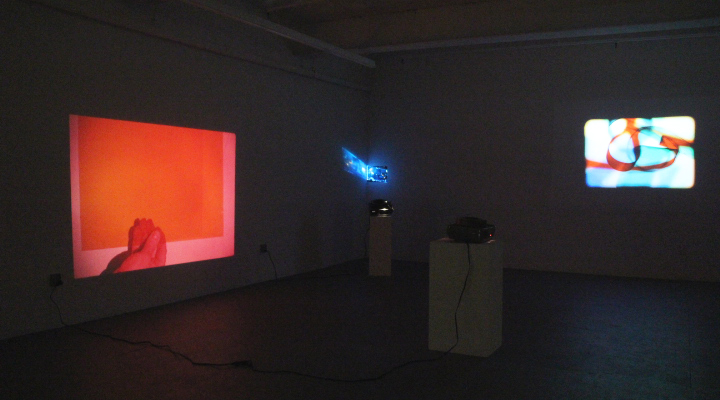
“Slide Slide Slide” exhibition (installation view with works by Michael Snow, Bradley Eros, Bruno Munari)
Special thanks to the Fondazione Jacqueline Vodoz e Bruno Danese
